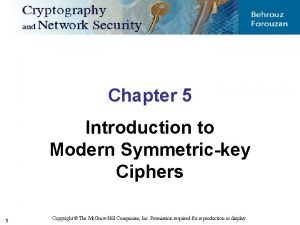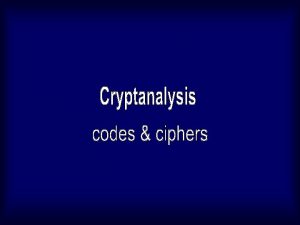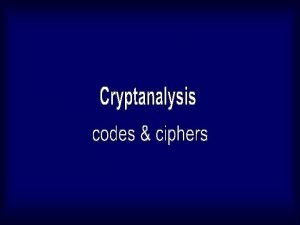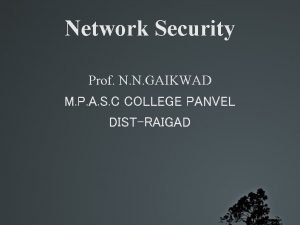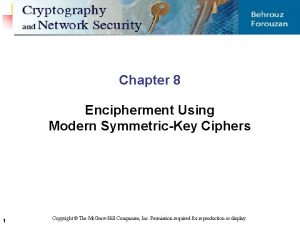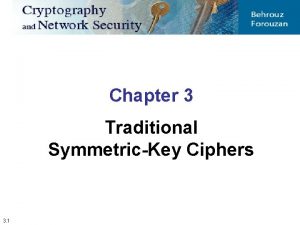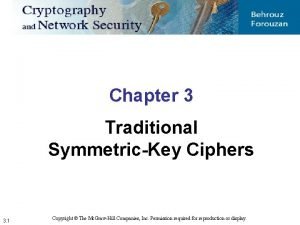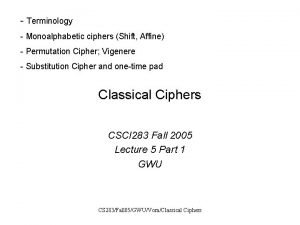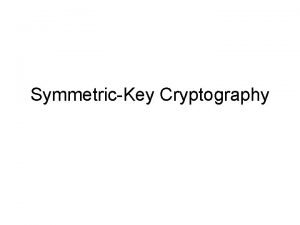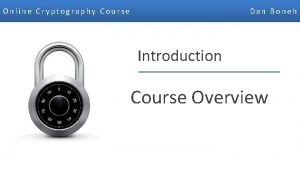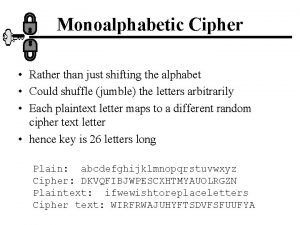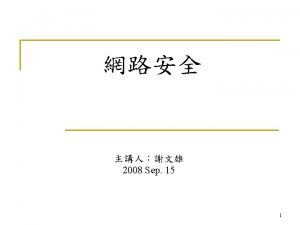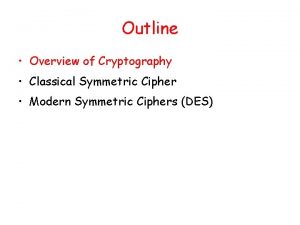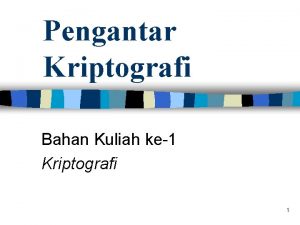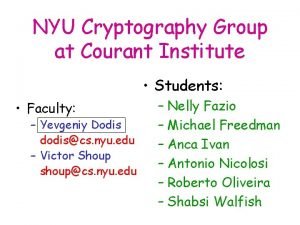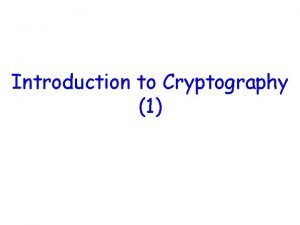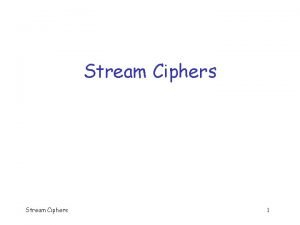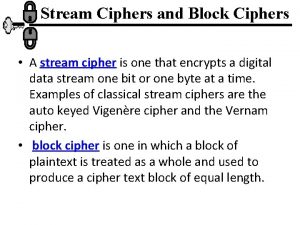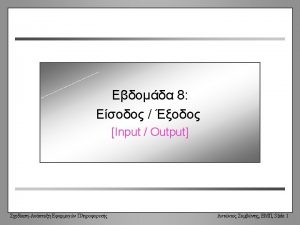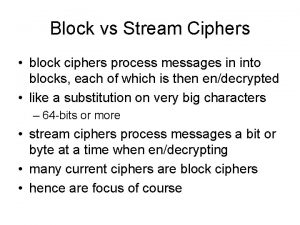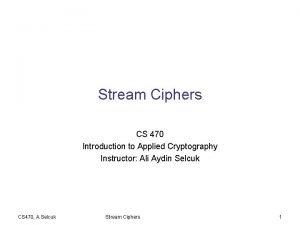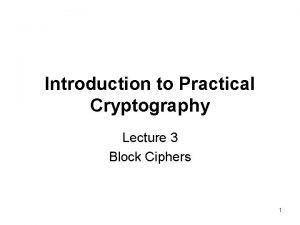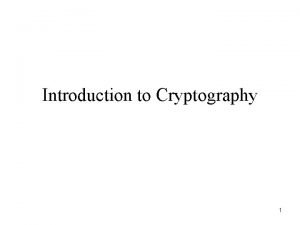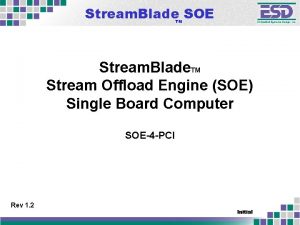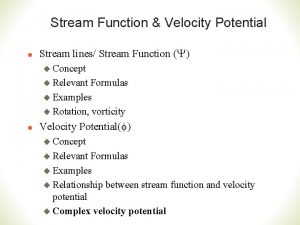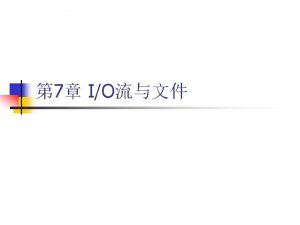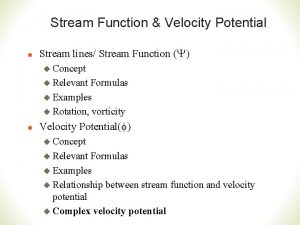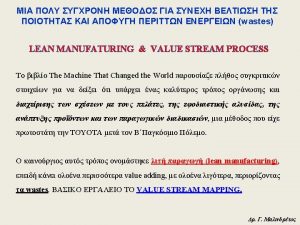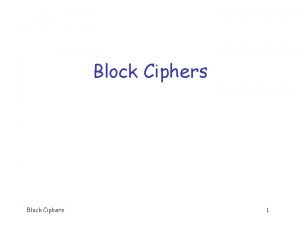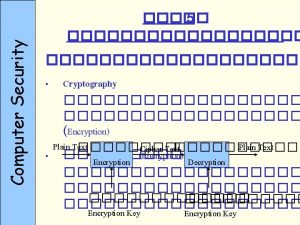Introduction to Practical Cryptography Lectures 34 Stream Ciphers






















































- Slides: 54

Introduction to Practical Cryptography Lectures 3/4 Stream Ciphers 1

Agenda • Properties • Building Blocks • Competitions • Examples 2

Uses • Encryption of streaming data • Random bit generation 3

Stream Ciphers • Stream cipher outputs keystream, KS • KS produced by a function, F, that is initialized with a key, k • C = Ek(P) = P KS • P = C KS • k can be used only once • • C 1 = Ek 1(P 1); C 2 = Ek 2(P 2) C 1 C 2 = P 1 KS 1 P 2 KS 2 = P 1 P 2 if KS 1 = KS 2 Will know when P 1 and P 2 have identical bits If know part of P 1 (if packet headers, format information), then can obtain part of P 2 • Period – how long is KS before it starts repeating? • repeating is equivalent to reusing a key 4

Stream Ciphers • Speed • Initialization • Keystream generation • Resources – memory, power, cpu • Hardware, software suitability 5

Stream Ciphers • Synchronous stream cipher • • • Sender and receiver must be in-synch Lost bit garbles all subsequent bits unless synch up Flipped bit garbles only one bit Can precompute key stream Example: RC 4, block cipher in OFB mode • Self-synchronizing stream ciphers • • • Use n previous ciphertext bits to compute keystream Lost bit: synch up after n bits Flipped bit : next n bits garbled Can’t precompute keystream Example: Block cipher in ciphertext feedback (CFB) mode 6

Stream Ciphers – General Concept state (data) key next state function output function State Updates • FSR based (SOBER, LILI) • Array Permutations (RC 4) ksi pi (ci) ci (pi) synchronous 7

Stream Ciphers – General Concept state (data) key next state function • error propagation • block cipher in CFB mode output function ksi pi (ci) subset of ci’s ci self synchronizing 8

Keystream Properties • Period of 232 repeats after ~ 8. 5 minutes when encrypting 1 MB/sec • Random appearance: • Runs of 1’s or 0’s: ½ with length 1, ¼ with length 2, 1/8 have length 3 … • Test – little or no compression • Dissipates statistics of plaintext • Complexity: • Low ability to define a bit as a linear expression (or algebraic expression) of bits < period bits away • No discernable relation to key (seed/initial state) bits 9

Agenda • Properties • Building Blocks • Competitions • Examples 10

Stream Ciphers - Approaches • Feedback Shift Register (FSR) based – useful in hardware • Block cipher – CTR, CFB, OFB modes • Components similar to those found in block ciphers 11

Feedback Shift Register bits, same concept with bytes, words State: bi values bn-1 bn-2 …… b 1 b 0 …… new bn-1 Tap Sequence: bits used in F F(bn-1, …. . b 0) Linear F: bn-1 = ibi for i {0, 1} i=0, n-1 Nonlinear F b 0 Feedback with Carry Shift (FCSR) F: s = ( ibi + c) for i {0, 1} i=0, n-1 bn-1 = s mod 2 12 c = s/2 mod log 2 (# tap bits)

Feedback Shift Registers • Period • LFSR of n bits: Maximum 2 n – 1 • FCSR: depends on initial state • Non-linear FSR: depends on function, initial state • Inefficient in Software • Small # of bits in tap sequence, easier to break. • Large # of bits in tap sequence, slow. • Security • Berlekamp-Massey Algorithm: 2 n output bits needed to reproduce the LFSR in O(n 2) time. • Non-linear FSR: avoid linear approximations 13

Variations Utilizing LFSR Combination generator • Output bit = nonlinear function on output of multiple LFSRs. • May clock each LFSR differently • Various combinations of AND, OR, Thresholds LSFR 1 LSFR 2 . . . nonlinear function keystream LSFRn 14

Variations Utilizing LFSR • Clock controlled generator • Move to next state only on some clock cycles. • Move to next state on every cycle but only output bit on some clock cycles. • 2 nd LFSR may control clock. • Clock control that affects output is also called stuttering 15

Clock Control Examples • Stop and Go: • 2 LFSRs • LFSR 1’s output clocks LFSR 2 • Alternating Stop and Go: • 3 LFSRs • output of LFSR 1 indicates whether to clock LFSR 2 or LFSR 3 • output is of LFSR’s 2 and 3 • Bilateral Stop and Go: • 2 LFSRs • output = of both outputs • clock LSRFs depending on their output values • Self-Decimated Generators: • control their own clock – some function of their state bits controls clock 16

Clock Control Examples • Shrinking Generator: • 2 LFSRs • always clock • if LFSR 1 outputs 1, use LFSR 2’s output, else no output on that cycle • called “shrinking” because fewer output bits than clock ticks • Self Shrinking Generator: • similar to shrinking generator but use 2 different bits from 1 LSFR instead of 2 LFSRs • Cascade: • output of 1 st level (may be single or combination of generators) controls clock of next level • usually not secure due to some relationship between 1 st level output and final output. 17

Agenda • Properties • Building Blocks • Competitions • Examples 18

NESSIE Stream Cipher Submissions • None recommended • BMGL – too slow, small internal state – time/memory tradeoff attack • Leviathan - distinguishing attack • LILI-128 – attack O(271) • SNOW – distinguishing attack • SOBER-t 16 – distinguishing attack • SOBER-t 32 – distinguishing attack • Both Sober algorithms thought to be subject to side channel analysis 19

ECRYPT’s e. Stream Contest • Just ended (3 rd round of evaluations finished, winners selected) • 4 for software, 4 for hardware • In third round of evaluations • 16 candidates • 3+ years from time of call for proposals to final report • originally November 2004 to January 2008 • Just ended • ECRYPT: European Network of Excellence for Cryptology 20

e. Stream Overview • Categories • key length of 128 bits and an IV length of 64 and/or 128 bits • key length of 80 bits and an IV length of 32 and/or 64 bits • Separate software and hardware categories within each • Evaluation • Security • Free of licensing requirements … • Performance, range of environments • Committee is only collecting submissions. Evaluations are done by the general cryptographic community. 21

e. Stream Evaluation • Security Criteria • Any key-recovery attack should be at least as difficult as exhaustive search. • Distinguishing attacks • Interest to the cryptographic community • Relative importance of high complexity distinguishing attacks is an issue for wider discussion • Clarity of design • Implementation Criteria • • Software and hardware efficiency Execution code and memory sizes Performance Flexibility of use 22

e. STREAM Phase 3 Candidates Profile 1 (SW) Profile 2 (HW) Crypt. MT (Crypt. MT Version 3) DECIM (DECIM v 2 and DECIM-128) Dragon Edon 80 HC (HC-128 and HC-256) F-FCSR (F-FCSR-H v 2 and F-FCSR-16) LEX (LEX-128, LEX-192 and LEX-256) Grain (Grain v 1 and Grain-128) NLS (NLSv 2, encryption-only) MICKEY (MICKEY 2. 0 and MICKEY-12 2. 0) Rabbit Moustique Salsa 20 Pomaranch (Pomaranch Version 3) SOSEMANUK Trivium http: //www. ecrypt. eu. org/stream/phase 3 list. html key lengths: 128 bits for SW and 80 bits for HW 23

e. STREAM Winners Profile 1 (SW) Profile 2 (HW) HC (HC-128 and HC-256) F-FCSR (F-FCSR-H v 2 and F-FCSR-16) Rabbit Grain (Grain v 1 and Grain-128) Salsa 20 MICKEY (MICKEY 2. 0 and MICKEY-12 2. 0) SOSEMANUK Trivium http: //www. ecrypt. eu. org/stream/ key lengths: 128 bits for SW and 80 bits for HW 24

Agenda • Properties • Building Blocks • Competitions • Examples 25

Stream Cipher Examples • Lists • http: //en. wikipedia. org/wiki/Stream_cipher • http: //www. ecrypt. eu. org/stream/ • RC 4 • A 5/1 • A 5/3 • LILI • Sober • Trivium • Lex 26

RC 4 S-Box Creation input key; if (key < 256 bytes) { repeat key until 256 bytes; } for (i=0; i < 256; ++i) { S[i] = i; // initialize S-Box K[i] = ith key byte; } j = 0; for (i = 0; i <256; ++i) { j = (j + S[i] + K[i]) mod 256; swap(S[i], S[j]); } Keystream Generator i = 0; j = 0; loop { i = (i+1) mod 256; j = (j+S[i]) mod 256; Swap(S[i], S[j]); t = (S[i] + S[j]) mod 256; ks_byte = S[t]; } 2 S-Box entries form index into S-Box Output S-Box entry (byte) S-Box: key dependent permutation of 0 to 255. (lookup table) 27

RC 4 Cryptanalysis • Initial keystream byte highly correlated with first few key bytes • Recommendations to discard first 256 or 512 output bytes • Distinguish from random: O(230. 6) bytes needed • Attempts to backtrack to initial state from keystream Keystream Generator i = 0; j = 0; loop { i = (i+1) mod 256; j = (j+S[i]) mod 256; Swap(S[i], S[j]); t = (S[i] + S[j]) mod 256; ks_byte = S[t]; } 28

A 5/1 • Used in Global System for Mobil Communications (GSM) • Example of a cipher manufacturers tried to keep secret, it was leaked and also reversed engineered within 5 years • A 5/2 – weaker cipher used in some countries due to export rules • GSM phone conversations are sent as sequences of frames. • One 228 bit frame is sent every 4. 6 milliseconds: 114 bits for the communication in each direction. • A 5/1 produces 228 bits to XOR with the frame • Initialized using a 64 -bit key combined with a publicly-known 22 -bit frame number. • In some GSM implementations, 10 key bits are fixed at zero - effective key length is 54 bits. • A 5/1 is based around a combination of three LFSRs with irregular clocking. 29

A 5/1 Image from Wikipedia 30

A 5/1 LSRFs • 19 bits • x 19 + x 5 + x 2 + x + 1 • clock bit 8 • tapped bits: 13, 16, 17, 18 • 22 bits • x 22 + x + 1 • clock bit 10 • tapped bits 20, 21 • 23 bits • x 23 + x 15 + x 2 + x + 1 • clock bit 10 • tapped bits 7, 20, 21, 22 • Least significant bit numbered 0 • Tapped bits of each LSRF are XORed to create value of next 0 bit. • Output bits of the three LSRFs are XORed to form the keystream bit 31

A 5/1 • Each cycle, look at the three clock bits. The majority value, cm, is determined. • In each LSRF, if the clock bit matches cm, the registers are clocked. • In each cycle, 2 or 3 LSRFs will be clocked. 32

A 5/1 Initialization • Registers set to all 0’s • Incorporate the key and frame number: • For 64 cycles, the key is mixed in by XORing the ith key bit with the least significant bit of each register • For 22 cycles, the 22 bit frame value is mixed in – same as with key value • Normal clocking used • 100 cycles are run using the majority clocking, the output is discarded • End result is the initial state 33

A 5/1 • Three short LSFRs • Not many tap bits to guess 34

A 5/3 Core • defined on next slide BLCNT is a 64 bit counter KM = 0 x 555…. 555 (128 bit key modifier) CK = key bits • CBC XORed with counter and key • A counter previous output 35

A 5/3 GSM • Kc = key • http: //www. gsmworld. com/using/algorithms/docs/a 5_3_and_gea 3_specifications. pdf 36

LILI Family of keystream generators Regularly clocked clocking function LFSRC LFSRD s 1 s 2 …sk s 1 s 2 …sn Fc c integer output FD Irregular: clocked c times bit for keystream. b non-linear function 37

SOBER - Original LFSR S 17 = 141 S 15 175 S 0 LFSR: 17 bytes, 128 bit key Clock Control Si’s Nonlinear transformation Vn = (S 0 + S 2 + S 5 + S 12) (S 12 S 13) Vn Output function (sc) 00: No output 01: Vn 01101001 10: Vn 11: Vn 10010110 Stutter Control Vn sc = next 2 bits of byte need byte: clock, take Vn Clock Control (sc) 00: 1 clock 01: clock, output, clock 10: 2 clocks 11: 1 clock sc output byte 38

Sober t{8, 16, 32} 8, 16, 32 = byte size of key 39

Sober-t LSFR for Sober-tw w = 8, 16, 32 Max period: 213 w-1 40

Non-linear Function LFSR output input to non-linear function fw, output added to subset of LSFRs bits, XORed with key-dependent value, this result then added to subset of LSRF bits 41

Trivium • Christophe De Canniere and Bart Preneel • hardware oriented synchronous stream cipher • Trivium generates up to 264 bits of key stream from an 80 -bit secret key and an 80 -bit initial value (IV). • Internal state is 288 bits 42

Trivium • IV and key used to initialize the state • Iterate state – extract values of 15 specific state bits and use them to update 3 bits of the state and to compute 1 bit of the key stream zi. – state bits then rotated and process repeats 43

Trivium Key Stream Generation for i = 1 to N do t 1 s 66 s 93 t 2 s 162 s 177 t 3 s 243 s 288 zi t 1 t 2 t 3 t 1 s 91 s 92 s 171 t 2 s 175 s 176 s 264 t 3 s 286 s 287 s 69 (s 1; s 2; : : : ; s 93) (t 3; s 1; : : : ; s 92) (s 94; s 95; : : : ; s 177) (t 1; s 94; : : : ; s 176) (s 178; s 279; : : : ; s 288) (t 2; s 178; : : : ; s 287) end for 44

Trivium Initialization • load 80 -bit key and 80 -bit IV into 288 -bit initial state • set all remaining bits to 0, except for s 286, s 287, and s 288, which are set to 1 • state is rotated over 4 full cycles of the for look, but no bits are output (for i = 1 to 4 288) 45

Trivium • state bit is not used for at least 64 iterations after it has been modified • up to 64 iterations can be computed at once, provided that 3 AND gates and 11 XOR gates in the original scheme are duplicated a corresponding number of times 46

Estimated Gate Counts 1 -bit to 64 -bit hardware implementations Components 1 -bit 8 -bit 16 -bit 32 -bit 64 -bit Flip-ops 288 288 288 AND gates 3 24 48 96 192 XOR gates 11 88 176 352 704 NAND gate count 3488 3712 3968 4480 5504 47

Software • • Stream generation: 12 cycles/byte Key setup: 55 cycles IV setup: 2050 cycles on Intel Xeon. TM CPU 1. 5 GHz 48

Trivium Security • Linear correlations between key stream bits and internal state bits are easy to find because zi is simply defined to be equal to s 66 s 93 s 162 s 177 s 243 s 288. • But, as opposed to LFSR based ciphers, Trivium's state evolves in a nonlinear way – not clear how an attacker should combine these equations in order to efficiently recover the state – Estimate: follow linear trails through the cipher and approximate the outputs of all encountered AND gates by 0. However, the positions of the taps in Trivium have been chosen in such a way that any trail of this specific type is forced to approximate at least 72 AND gate outputs – If assume that the correlation of linear combination is completely explained by a specific trail considered, then it would have a correlation coefficient of 2 -72 • Detecting such a correlation would require at least 2144 bits of key stream • Other more complicated types of linear trails with larger correlations might exist, estimate that no correlations will exceed 2 -40 49

Lex • Alex Biryukov • Leak EXtraction • Software category – Uses AES – reuse if application has AES implementation 50

Lex • Initialize: – Key AES: 128 -bit key, K, run through standard AES key-schedule – State: 128 -bit IV is encrypted by AES S = AESK(IV ) • Generate key stream – Repeatedly encrypt (starting with S) • Rekey every 500 AES applications 51

Lex takes 4 bytes from each round of AES (see next slide) 52

Lex 53

Lex • order of bytes – not relevant for security – relevant for fast software implementation • allows extraction of a 32 -bit value from two 32 -bit rows in four steps ((t 0&0 x. FF 00 FF) << 8) (t 2&0 x. FF 00 FF) t 0 = 1 st row, t 2 = 3 rd row in 4 x 4 matrix 54
 Modern symmetric key ciphers
Modern symmetric key ciphers Differentiate byte stream and character stream
Differentiate byte stream and character stream Polygraphic substitution cipher
Polygraphic substitution cipher Polygraphic cipher
Polygraphic cipher Keyed and keyless transposition ciphers
Keyed and keyless transposition ciphers Encipherment
Encipherment Traditional ciphers
Traditional ciphers All ciphers
All ciphers Modern block ciphers
Modern block ciphers Modern block cipher in cryptography
Modern block cipher in cryptography Cipher substitution
Cipher substitution Transposition cipher decryption example
Transposition cipher decryption example Cryptography course online
Cryptography course online Monoalphabetic cipher definition
Monoalphabetic cipher definition Monoalphabetic
Monoalphabetic Des round structure
Des round structure Guide to codes and ciphers
Guide to codes and ciphers Modern symmetric ciphers
Modern symmetric ciphers Introduction to network security and cryptography
Introduction to network security and cryptography Intro to cryptography
Intro to cryptography Nyu introduction to cryptography
Nyu introduction to cryptography Introduction to cryptography and network security
Introduction to cryptography and network security Birthday attack
Birthday attack Introduction to cryptography and network security
Introduction to cryptography and network security Rick trebino lectures
Rick trebino lectures Lectures paediatrics
Lectures paediatrics Data mining lectures
Data mining lectures Advanced medicinal chemistry
Advanced medicinal chemistry Uva powerpoint
Uva powerpoint Cs614 short lectures
Cs614 short lectures Activity planning software project management
Activity planning software project management Molecular biology lectures
Molecular biology lectures Radio astronomy lectures
Radio astronomy lectures Dr sohail lectures
Dr sohail lectures Utilities and energy lecture
Utilities and energy lecture Web engineering lectures ppt
Web engineering lectures ppt Do words have power
Do words have power Frcr physics lectures
Frcr physics lectures Frequency of xrays
Frequency of xrays Introduction to recursion
Introduction to recursion Blood physiology guyton
Blood physiology guyton Define aerodynamics
Define aerodynamics Theory of translation lectures
Theory of translation lectures Power system lectures
Power system lectures Theory and practice of translation lectures
Theory and practice of translation lectures Theory of translation lectures
Theory of translation lectures Digital logic design lectures
Digital logic design lectures Jim kurose gaia
Jim kurose gaia Philosophy of fine arts
Philosophy of fine arts Nuclear medicine lectures
Nuclear medicine lectures Cs106b lectures
Cs106b lectures Cdeep lectures
Cdeep lectures Oral communication 3 lectures text
Oral communication 3 lectures text C programming lectures
C programming lectures Haematology lectures
Haematology lectures
